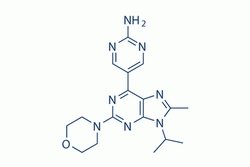| Cas No.: | 1246560-33-7 |
| Chemical Name: | SB-2343; VS5584; VS 5584; SB2343; SB 2343 |
| Synonyms: | SB-2343; VS5584; VS 5584; SB2343; SB 2343 |
| SMILES: | CC1=NC2=C(N=C(N=C2N1C(C)C)N3CCOCC3)C4=CN=C(N=C4)N |
| Formula: | C17H22N8O |
| M.Wt: | 354.41 |
| Sotrage: | 2 years -20°C Powder, 2 weeks 4°C in DMSO, 6 months -80°C in DMSO |
| Description: | VS-5584 is a pan-PI3K/mTOR kinase inhibitor with IC50s of 16 nM, 68 nM, 42 nM, 25 nM, and 37 nM for PI3Kα, PI3Kβ, PI3Kδ, PI3Kγ and mTOR, respectively. VS-5584 simultaneously blocks mTORC2 as well as mTORC1. |
| In Vivo: | Nude mice bearing MDA-MB-231 human breast cancer tumors are treated for 5 days with once daily oral VS-5584 (25 mg/kg). Oral treatment of tumor bearing mice with VS-5584 reduces cancer atem cells analyzed from extracted tumors. Mice are implanted with tumor fragments from a docetaxel-resistant patient-derived triple negative breast cancer. Mice are treated with VS-5584 (20 mg/kg, po, qd) or Docetaxel (20 mg/kg, i.v.). Oral VS-5584 induces tumor regression in a Docetaxel-resistant patient-derived breast cancer model[1]. A single oral dose of VS-5584 is rapidly absorbed with a tmax of 0.9 hours and an elimination half-life of 10 hours. To determine the pharmacokinetic and pharmacodynamic relationship in tumors, PC3-tumor–bearing mice are treated with a single dose of VS-5584 and plasma and tumors are harvested after 6 hours and analyzed for concentrations of VS-5584 and effects on target efficacy biomarkers. Plasma levels of VS-5584 increase dose-dependently. For evaluation of efficacy in a Rapamycin-sensitive PC3 engraftment model, tumor-bearing mice are treated with VS-5584 for 28 days in comparison with the rapalog Everolimus. VS-5584 is well tolerated at both doses tested (11 and 25 mg/kg) with minimal weight loss (mean 4.7% on day 27). Treatment with VS-5584 leads to significant tumor growth inhibition (TGI) of 79% and 113% for 11 and 25 mg/kg, respectively[1]. |
| In Vitro: | VS-5584 is an ATP-competitive inhibitor which selectively inhibits PI3K/mTOR signaling with equivalent low nanomolar potency against all human Class I PI3K isoforms and mTOR kinase. VS-5584 (0.001, 0.01, 0.1,1,10 and 100 μM) preferentially inhibits cancer stem cells in HMLE breast cancer cells while Paclitaxel increases the percentage of cancer stem cells. VS-5584 (0.1, 1, 10, 100 and 1000 nM) reduces the number of Aldefluor-positive cancer stem cells while Paclitaxel increases the percentage of cancer stem cells. VS-5584 (10, 30, 100, 300 nM) reduces the percentage of cancer stem cells (side population) in a Hoechst dye exclusion assay[1]. VS-5584 is a potent inhibitor of mTOR (IC50=37 nM) as well as class I PI3K isoforms (IC50: PI3Kα=16 nM; PI3Kβ=68 nM; PI3Kγ=25 nM; PI3Kδ=42 nM). All other evaluated kinases show negligible binding when tested up to 10 μM VS-5584[1]. |

 To enhance service speed and avoid tariff delays, we've opened a US warehouse. All US orders ship directly from our US facility.
To enhance service speed and avoid tariff delays, we've opened a US warehouse. All US orders ship directly from our US facility.




















